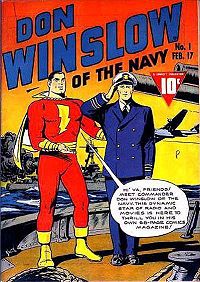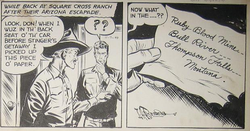
Don Winslow of the Navy (comics)
Encyclopedia

Comic strip
A comic strip is a sequence of drawings arranged in interrelated panels to display brief humor or form a narrative, often serialized, with text in balloons and captions....
distributed by the Bell Syndicate
John Neville Wheeler
John Neville "Jack" Wheeler was an American newspaperman, publishing executive, magazine editor, and author. He was born in Yonkers, New York, graduated Columbia University , was a veteran of World War I serving in France as a field artillery lieutenant, began his newspaper career at the New York...
from 1934 to 1955. The title character was a spychasing Lieutenant Commander in Naval intelligence. The comic strip led to a radio adventure serial that began in 1937, as well as a film serial that began in 1942. Original comics stories also appeared in Fawcett
Fawcett Publications
Fawcett Publications was an American publishing company founded in 1919 in Robbinsdale, Minnesota by Wilford Hamilton "Captain Billy" Fawcett . At the age of 16, Fawcett ran away from home to join the Army, and the Spanish-American War took him to the Philippines. Back in Minnesota, he became a...
comic book
Comic book
A comic book or comicbook is a magazine made up of comics, narrative artwork in the form of separate panels that represent individual scenes, often accompanied by dialog as well as including...
s starting in 1943.
Conceived as recruitment tool
The idea for Don Winslow was conceived by Lieutenant Commander Frank V. Martinek USNR, himself a storied veteran of World War IWorld War I
World War I , which was predominantly called the World War or the Great War from its occurrence until 1939, and the First World War or World War I thereafter, was a major war centred in Europe that began on 28 July 1914 and lasted until 11 November 1918...
Naval intelligence, after Admiral Wat T. Cluverius complained to him about the difficulties of recruiting in the Midwest. Ruminating on the challenge, Martinek decided that a comic strip that focused on Naval tradition and courage would educate and fascinate America’s youth. He had previously used the character Don Winslow in some novels he wrote, so he had the main concept readymade. Colonel Frank Knox
Frank Knox
-External links:...
, later Secretary of the Navy helped sell the idea to the Bell Syndicate.
All hands on deck
While Martinek gave the strip an air of authenticity, he brought in Naval Lieutenant Leon Beroth as art director and Carl Hammond to handle layouts and research. Martinek articulated this central principle: "Since Don Winslow of the Navy is approved by the Navy Department, I cannot allow him to do anything that is contrary to the ideals, traditions or motives of the Navy."
Ken Ernst
Kenneth Ernst , known professionally as Ken Ernst, was an US comic book and comic strip artist. He is most notable for his work on the popular and long-running comic strip Mary Worth from 1942 to 1985. With his realistic style, uncommon in those early years, Ernst paved the way for soap opera...
(later famous for Mary Worth), assisted or ghosted the art between 1940 and 1942. With Don leaving his fiancee behind in December 1941 to go fight the Japanese, the World War II
World War II
World War II, or the Second World War , was a global conflict lasting from 1939 to 1945, involving most of the world's nations—including all of the great powers—eventually forming two opposing military alliances: the Allies and the Axis...
period saw the height of Don Winslow’s popularity. The strip continued for a full decade after the war ended, coming to a close on Saturday, July 30 1955.
Although created primarily as a Navy recruitment and propaganda
Propaganda
Propaganda is a form of communication that is aimed at influencing the attitude of a community toward some cause or position so as to benefit oneself or one's group....
tool, the strip received high marks from Coulton Waugh
Coulton Waugh
Frederick Coulton Waugh was a cartoonist, painter, teacher and author, best known for his illustration work on the comic strip Dickie Dare and his book The Comics , the first major study of the field.His father was the marine artist Frederick Judd Waugh, and his grandfather was the Philadelphia...
for “excellent suspense, and ingenious, spine-joggling situations.” Ron Goulart
Ron Goulart
Ron Goulart is an American popular culture historian and mystery, fantasy and science fiction author.The prolific Goulart wrote many novelizations and other routine work under various pseudonyms: Kenneth Robeson , Con Steffanson , Chad Calhoun, R.T...
credits Don Winslow with "intrigue, spychasing, beautiful women, and villains with names like Dr. Centaur, the Dwarf, and the Scorpion." Like all good propaganda, the strip first sought to grab the reader's attention.
Comic book versions

Comic book
A comic book or comicbook is a magazine made up of comics, narrative artwork in the form of separate panels that represent individual scenes, often accompanied by dialog as well as including...
form appeared from various publishers. Merwil, a small publisher, offered reprints in 1937. In 1938 Dell Comics
Dell Comics
Dell Comics was the comic book publishing arm of Dell Publishing, which got its start in pulp magazines. It published comics from 1929 to 1973. At its peak, it was the most prominent and successful American company in the medium...
began reprinting the newspaper strips in Crackajack Funnies alongside other established newspaper features. When that title ceased publication in 1942, Don Winslow reprints begin running in Popular Comics, again with other strip favorites of the era. In addition, Dell also had Don Winslow in two issues of their Four Color Comics, a series which spotlighted a different character with nearly every issue. Dell's 1938 oneshot, Famous Feature Stories, contained more Winslow.
Fawcett Publications
Fawcett Publications
Fawcett Publications was an American publishing company founded in 1919 in Robbinsdale, Minnesota by Wilford Hamilton "Captain Billy" Fawcett . At the age of 16, Fawcett ran away from home to join the Army, and the Spanish-American War took him to the Philippines. Back in Minnesota, he became a...
released the Don Winslow of the Navy comic book with original stories beginning in 1943. The cover of the first issue shows Captain Marvel
Captain Marvel (DC Comics)
Captain Marvel is a fictional comic book superhero, originally published by Fawcett Comics and later by DC Comics. Created in 1939 by artist C. C. Beck and writer Bill Parker, the character first appeared in Whiz Comics #2...
introducing Don Winslow to the readers. This comic book title lasted until 1948, then was revived in 1951 (bringing the total to 69 issues). Winslow was revived again for a final brief time starting in 1955 in reprints published by Charlton Comics
Charlton Comics
Charlton Comics was an American comic book publishing company that existed from 1946 to 1985, having begun under a different name in 1944. It was based in Derby, Connecticut...
.

